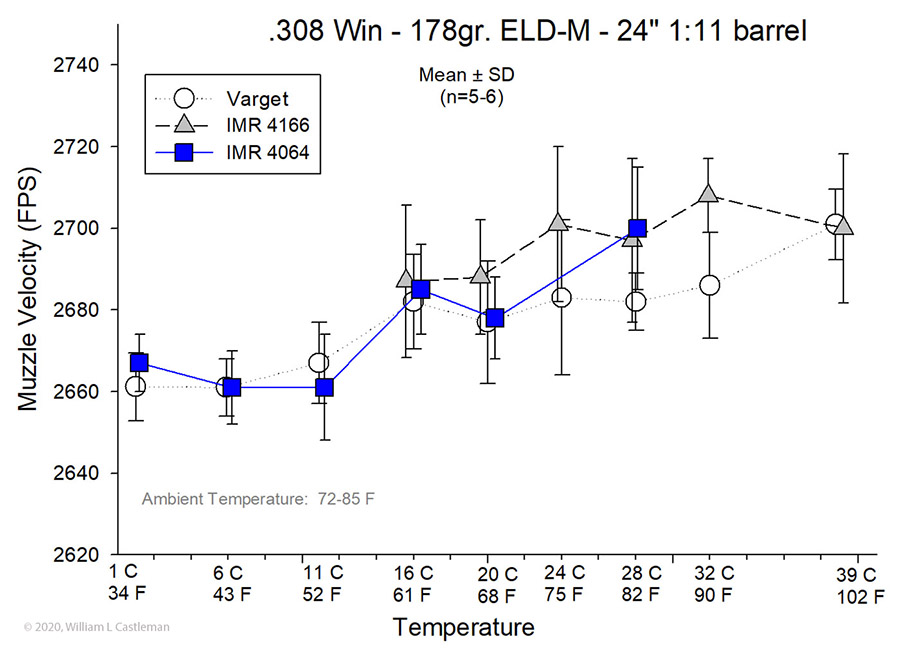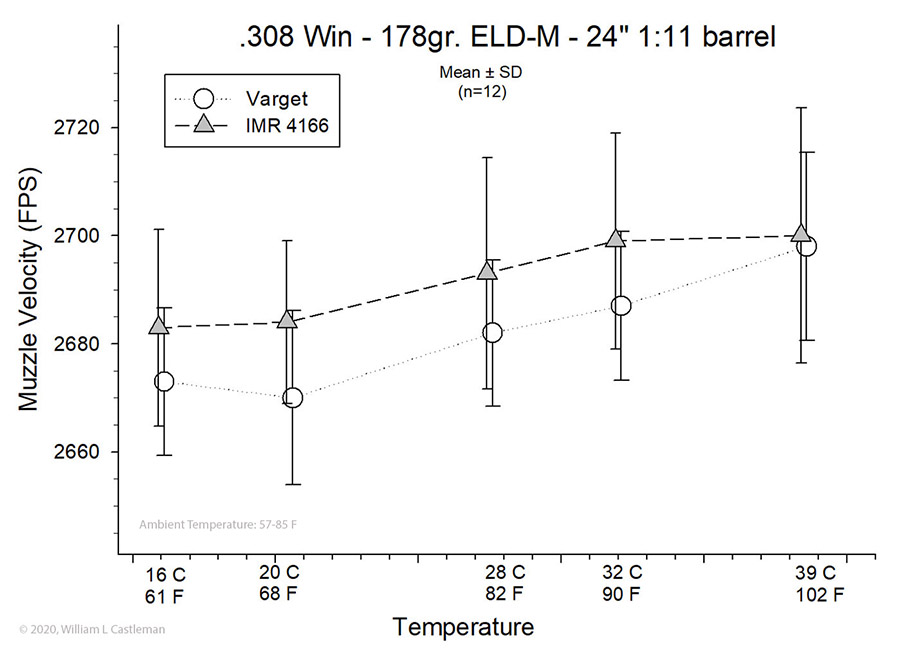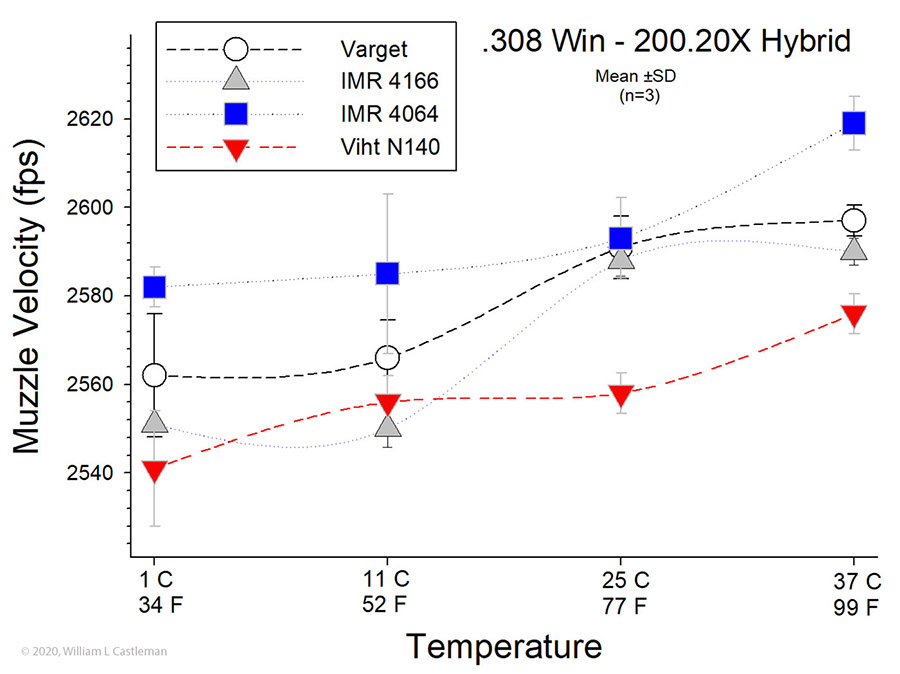Temperature Insensitivity of Varget,
IMR 4166,
IMR 4046 and Vihtavuori N140 for .308 Win F-TR
Tests for a Possible Varget Powder Replacement in a .308 Win F-TR Rifle
Like many other F-TR shooters, I have been using Varget powder for bullets in the 175 to 208 grain range. Varget's positive reputation for being relatively insensitive to temperature-dependent velocity changes puts it in great demand. Unfortunately, this popularity and high demand coupled with limited importation of powder produced in Australia and marketed as Varget in the United States has resulted in recurring shortages to U.S. shooters. This website reports results of temperature-velocity tests that I ran with Varget and 3 other rifle powders reported to perform well by competitive F-TR shooters. The purpose of the studies was to identify a powder or powders that may have temperature insensitivity comparable to that of Varget. The temperatures I used in the tests cover the range that I experience in F-TR rifle matches in North Central Florida (34°F to 102°F).
Test 1
The first test was a wide-range survey of 4 powder temperature-velocity responses. The initial tests only used 3 replicates shots per powder per temperature. Data from the first test would be used to conduct a more detailed second test with promising powders.
Powders and Loads Tested in Lapua case with 200 grain bullet :
1. Varget (lot 1112019 7145) - 42.2 grains
2. IMR 4166 (lot 1040419 6417) - 41.7 grains
3. IMR 4064 (lot 1020420 2779) - 41.7 grains
4. Vihtavuori N140 (lot 01.12.2017) - 41.7 grains
Rifle/Brass/Bullet for Test 1: .308 Winchester bolt action rifle with 30 inch Bartlein 5R 1:10 barrel; Lapua Palma brass (4X reloaded following neck resizing at 0.002 tension); CCI BR4 primer; Berger 200.20X Hybrid bullets loaded at 3.02 inches COAL (0.02" off lands)
A Varget load for the cartridge that gave 0.39 MOA accuracy performance at 200 yards (2583 FPS at 71 degrees Fahrenheit) was selected. The IMR 4064 load was calculated using QuickLoad V.3.9 (2015 database) to achieve similar velocity using a Berger 200 gr hybrid bullet for the bullet value and default temperature setting of 70 F. The IMR 4166 load used was the same grain weight value as the IMR 4064 load since the two powders have been reported to have comparable performance. The N140 load was set at a lower velocity performance level because I was uncertain of its temperature sensitivity at higher temperatures, and I didn't want to reach over pressure levels. Powder charge was measured with a RCBS Charge Master 1500 for this first test and changed to a less variable method in the second test.
Temperature Adjustment and Velocity Measurements: Cartridge temperatures were established by double bagging loaded cartridges in plastic sandwich bags and placing them in containers of water at: 1) 1 C (ice water); 2) ice cooled tap water (11 C) in a large mouth Yeti bottle; 3) tap water (25 C) in a large volume water cooler; and 4) warm tap water (37 C) in a 36 oz. Yeti bottle. Cartridges were held at temperature for at least 90 minutes before being fired in the rifle. Water temperatures were measured with a scientific mercury thermometer (FisherScientific) with Celsius scale. Velocity was measured with a MagnetoSpeed Sporter. The temperature order of the test was: #1 - 25C; #2 - 37C; #3 - 1C; #4 - 11C. Ambient temperature during the test varied from 72 to 74F; 69-82% relative humidity and 30.05 mm Hg pressure at 140 feet elevation.
The barrel was cooled with a barrel cooler (Chamber Chiller) for 10-15 minutes between each 12-shot string.
|
The initial results had variable, and sometimes large, standard deviations. Differences in standard deviation among temperatures and powders in this first study were suspected to be due to relative imprecision in powder measurement of the Charge Master 1500 and the small replicate number, rather than inherent powder properties. This was examined further in a test of the Charge Master 1500 against an AutoTrickler system linked to a Sartorius Entris balance. Results of the test are shown HERE. For the Charge Master 1500 dispensing 43.2 grains of powder, variation in charge per cartridge could be by as much as 0.3 grains.
Bullet velocity versus temperature responses to temperature did not appear to be simple linear responses on linear axes, so a splined best fit curve was used for this preliminary data.
There were variable changes in velocity per degree change in temperature in different areas of the temperature curve. The differences in the means at various segments of the temperature range are tabulated in the following panels.
Increase in Velocity per Degree Increase in Temperature Between 1 and 37°C (34-99°F):
|
Increase in Velocity per Degree Increase in Temperature Between 11 and 37°C (52-99°F):
|
||||||||||||||||||||||||||||||
|
|
Summary of Findings from Preliminary Test 1 with Four Rifle Powders:
Although there are small numbers of mean data points with variable standard deviations, there are several observations worth discussing.
If one looks at velocity change per degree change in this study over the entire range of measurement (1 to 37°C or 34 to 99°F), Varget and
Vihtavuori N140 appear to offer better performance (temperature insensitivity) than do the other two powders. A dfferent pattern emerges when one examines powder performance in individual blocks of 20 to 25 degrees Fahrenheit. In the temperature range between 77°F and 99°F, Varget and IMR 4166 appear to offer better temperature insensitivity than do the other two powders. Conversely, greater temperature insensitivity appears to be shown by IMR 4046 and Vihtavuori N140 than the other two powders in the cooler temperature range from 34 to 77°F. IMR 4046 had the best performance (temperature insensitivity) in this range.
| How Well Did QuickLoad v. 3.9 Do in Predicting Velocity at Different Temperatures? I initially used the database available in my 2015 puchased copy of QuickLoad. I updated to the March 9, 2020 version. Predictions from the 2020 update for Varget and IMR 4064 were essentially the same as the 2015 version. The 2020 database was grossly inaccurate for predicting velocity at any temperature for IMR 4166 and for N140. Varget: Good predictions at 52 and 77°F. Poor prediction at higher and lower temperature (see graph). IMR 4166 (2015 version using IMR 4064 profile): Good predictions at 77°F and 32°F. Poor predictions at other temperatures (see graph). IMR 4166 (2020 version): Grossly inaccurate even at the base setting of 70°F (see graph). IMR 4064: Good prediction at 77°F. Poor predictions at other temperatures (see graph). Vihtavuori N140 (2015 version): Approximate prediction at 77°F (off by 10 FPS). Poor predictions at other temperatures (see graph). Vihtavuori N140 (2020 version): Grossly inaccurate at all temperatures. see graph). |
Preliminary Conclusions Based on Study 1:
-
IMR 4166 appeared to be as temperature insensitive or more insensitive than Varget in the temperature range between 77 and 99°F.
- IMR 4046 appeared to be as temperature insensitive or more temperature insensitive than Varget in the range from 34 to 77°F
- Vihtavuori N140 appeared to have excellent insensitivity to temperature-induced velocity changes over a wide temperature range
Test 2
The objectives of the second study were to compare insensitivity of temperature-induced velocity changes of IMR 4166 and IMR 4064 to that of Varget. IMR 4166 was studied from 61 to 102° F. IMR 4064 was studied from 34 to 82° F. Temperature difference between points studied were targeted at roughly 10°F intervals with at least 5 replicate data points per temperature. Powder charges were weighed using the AutoTrickler system and a Sartorius balance in order to minimize charge variations.
Available supplies of bullets and brass warranted a shift to another rifle with a 24 inch barrel that I have used in 600 yard F-TR matches and another bullet/cartridge. Features of the rifle/cartridge combination were:
Rifle for Test 2: .308 Win Rifle, Brux M24 Contour barrel, 1:11 twist, 24” (>2600 rounds through it).
Cartridge/Powder Load for Test 2: 178gr ELD-M, 43.8gr Varget, 2.84” COAL (0.02” off lands), Lapua brass (3 or 4 reloads with neck resize only: 0.002” tension), CCI BR2 primer. Powder loads for IMR 4166 and IMR 4064 were 43.2gr. All powder loads filled the available cartridge space with an estimated 4.2 to 5.7% compression of powder.
Note: Studies with Vihtavuori N140 did not continue because calculations based on available data and QuickLoad (2015 database) indicated that it would not be possible to load enough powder in available case volume to get sufficiently high velocities with 200-plus grain bullets to be competitive at 1000 yards.
 Test 2 data based on 5 to 6 replicate shots per temperature for each powder. |
For IMR 4064, increases in velocity with increasing temperature followed the profile of Varget between 34°F and 68°F. However, between 68°F and 82°F, IMR 4064
appears to become more sensitive to temperature changes than Varget.
For IMR 4166, temperature-induced increases in velocity appeared to be comparable to those of Varget between 61°F and 102°F. However, standard deviations remained high.
| Why does the standard deviation remain so high? With the increased accuracy and consistency of powder charge weights using AutoTrickler and a Sartorius balance, there was an a decrease in standard deviation of measured velocities. However, the standard deviation in velocity was still high in Test 2 results. I wondered it there was inherent inaccuracy in the MagnetoSpeed Sportster or if the method of handling cartridges at ambient temperature after they were heated/cooled to 30 or 40 degrees Fahrenheit above and below ambient temperature was a major contributor. In the first examination of the problem, ambient-temperature, Varget-loaded cartridges were fired over my MagnetoSpeed Sporter probe and through the sensor window of my ProChrono Digital chronometer and velocity was recorded for 10 shots. Results shown HERE demonstrate that both chronometers measure similar velocity and have similar standard deviations in ambient temperature (12 FPS for 10 shots). The higher standard deviations in Test 2 (SD's up to 20) were attributed to handling the cartridges at ambient temperature and inducing variations in velocity. Several methods were tried to get around this (e.g., wearing gloves; heating cartridges in water while cartridges were protected in 50ml centrifuge tubes) with no apparent improvement. |
Because a higher than desireable level of variation occurred in the velocity data for the IMR 4166 data between 61°F and 102°F, I tried to decrease the standard deviation and increase a more confident approximation of the mean velocity values by increasing the number of data replicates per temperature from 6 to 12. The amended results with 12 samples per temperature are presented in the following graph.
 IMR 4166 and Varget velocities and standard deviations plotted versus temperature with 12 replicates per data mean. IMR 4166 and Varget velocities and standard deviations plotted versus temperature with 12 replicates per data mean. |
The rates of velocity-induced temperature increase for IMR 4166 and Varget are very similar between 61°F and 103°F. From mean data depicted in the graph, the rate increase for IMR 4166 is 0.32 FPS per degree Fahrenheit increase, whereas the rate increase for Varget is 0.46 FPS per degree Fahrenheit. While the value is lower for IMR 4166, it is unlikely to be statistically different based on the high standard deviations.
Conclusions
The primary goal of these studies was to identify powders for .308 Win F-TR rifles that had similar insensitivities to temperature-induced increases in velocity as Varget. IMR 4064, IMR 4166 and Vihtovuori N140 were tested between 34°F and 102°F. No powder matched the overall performance of Varget across the full temperature range. N140 had similar temperature insensitivity to that of Varget across the full temperature spectrum. However, N140 was estimated to be of limited value in F-TR rifles shooting 200-plus grain bullets given the limited case volume and velocity needed to be competitive at 1000-yard shooting distances.
> IMR 4064 had very similar temperature insensitivity to that of Varget between 34°F and 68°F and was able to produce high velocity for 1000-yard shots with 200-plus grain bullets.
> IMR 4166 had very similar temperature insensitivity performance to that of Varget between 61°F and 103°F and was able to produce high velocity for 1000-yard shots with 200-plus grain bullets.
Depending on the temperature range in which you are shooting, either IMR 4064 (lower ambient temperatures) or IMR 4166 (higher ambient temperatures) were considered to be good replacements for Varget in .308 Win F-TR shooting if needed.
posted 25 March, 2020, last updated 3 April 2020
© 2020, William L. Castleman
